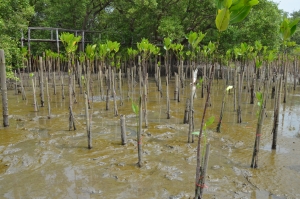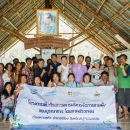Newsroom :: News :: MFF, Marriott and Sukhothai Thammathirat Open University collaborate for Thailand's coastal resources
MFF, Marriott and Sukhothai Thammathirat Open University collaborate for Thailand's coastal resources
Location: Bangkaeo, Thailand. 3rd Apr 2018
Co-funded by MFF and Marriott Hotels and Resorts, an IUCN partner, the initiative is part of MFF’s Small Grant Facility for Private Sector Engagement, in which MFF matches cash funding from the private sector to implement small projects in MFF countries.
The objectives of the initiative, which started in March, are primarily to establish an Integrated Coastal Management (ICM) network, develop a community-based land use map and sustainable management plan, and to utilise the management plan to restore mangroves and create sustainable livelihood opportunities.

Second workshop of the Community-based Integrated Coastal Management Project, Mangrove Classroom Learning Center, Bangkaeo © STOU
To date, conservation initiatives in the district have been carried out independently, by different organisations. The lack of a collaborative and integrated approach meant that information and knowledge could not be systematically shared and leveraged.
This project aims to break down the barriers to collaboration by establishing a network which will link different sectors and conservation stakeholders, prioritise community needs, and facilitate the sharing and uptake of best practices.
Located on the coast of Thailand’s Samut Songkram Province, 80 km southwest of Bangkok, Bangkaeo comprises mainly communities that depend on fish and other coastal resources for their livelihoods. Unfortunately, in recent years, the area has been facing a natural resource crisis.
The removal of mangrove forests to make way for shrimp ponds – many of which were abandoned when disease decimated shrimp stocks – has made the area increasingly vulnerable to coastal erosion. This threat has been intensified by climate change as well as rising sea levels.
“Coastal erosion is a high-priority issue in Thailand, and the loss of mangrove forests, which would normally protect the coast and act as a sort of nursery for young fish, is only making the situation worse,” said Steen Christensen, MFF coordinator.
To combat coastal erosion, villages have tried to use traditional techniques, such as building bamboo embankments to trap sediment and protect mangrove saplings. Unfortunately, success was limited due to the lack of coordination among key stakeholders.
Semipermeable bamboo walls allow sediment and water through, but protect young mangroves from the open sea © Elaine Mumford / IUCN
“The university and the Department of Marine and Coastal Resources previously carried out research on coastal erosion with networks in five provinces around the Upper Gulf of Thailand, including Samut Songkram,” explains Dr Dusit Wechakit, Community-Based Resources Management and Capacity Building Center, Sukhothai Thammathirat Open University (STOU). “From the start, the Bangkeao village headman and his conservation network have been working hard to fight coastal erosion. The community’s bamboo fences and mangrove restoration efforts have great potential, so we have been continuing to work in Bangkaeo to strengthen the locals’ capacity. The project will not only benefit the Bangkaeo community, but possibly also the whole province and the rest of Thailand’s coastline.”
Recognising the importance of preventing coastal erosion in Bangkeao, IUCN and Marriott partnered to plant 4,000 mangrove saplings in the area in 2015. The project was meant to raise awareness among Marriott associates, especially hotel culinary professionals, about the link between the seafood they used in their work and the coastal ecosystem around them, and to get them more tangibly involved in conservation.
“The new ICM network is crucial to consolidating the work that has already been done in Bangkeao,” said Trevor May, Marriott Thailand Business Council President. “This project will build on the traditional practices initiated by the communities, as well as the mangrove restoration we undertook with MFF, to create something more sustainable in the long run.”
An informational signboard marks the area where Marriott, in collaboration with IUCN and MFF, planted 4,000 mangrove saplings over 5 rai (0.8 hectares) © Elaine Mumford / IUCN
On 6 March 2018, the first meeting of the project was held to update participants on the current situation and discuss solutions for issues occurring in the ten participating Bangkaeo villages. The communities are experiencing a decline in fish and seafood harvest due to illegal wastewater discharge from factories and illegal fishing methods, and as a result, local people are giving up fishing to work in those same factories. Land lost due to coastal erosion, ineffective coastal erosion mitigation measures due to lack of engagement from private land owners, and the lack of bamboo fence maintenance were the main concerns raised during the small group discussion. The participation of women in the project was also identified as a major consideration for the project, and their involvement in the implementation process paramount to its success.

